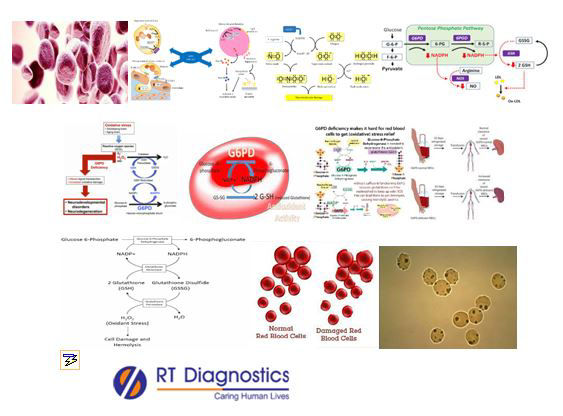G6PD:
Why G6PD Test?
CLINICAL INFORMATION
Aerobic organisms, higher vertebrates and mammals (Aerobic Cellular Respiration) consume of molecular oxygen for their survival, consequently, it results in the formation of a number of oxygen-containing reactive species, collectively known as Reactive Oxygen Species – ROS. Therefore ROS are typical byproducts of cellular oxidative metabolism in the mitochondria of each cell in multicellular organisms. Examples of ROS are peroxidases, superoxide, hydroxyl radical, singlet oxygen, alpha oxygen etc. ROS can also be formed by the cellular response to xenobiotics (breakdown of toxic compounds like antibiotics etc), infections, cytokines etc. ROS has a significant role in the modulation of cell survival, cell differentiation, cell death, cell signalling and synthesis of inflammation-related factor production etc. ROS is also found to be associated with numerous pathologies such as causing damage to DNA by a spontaneous mutation that may lead to cancer (it can be screened for diagnosis by estimating oxidized DNA bases in urine specimens after DNA repair). ROS levels are elevated during fever and/or infection. As a result to combat these ROS; the Antioxidants like glutathione, zinc, selenium, vitamin C, vitamin E, carotenoids like beta-carotene etc, and also the antioxidant enzymes like superoxide dismutase, G6PD, catalase, glutathione peroxidase, glutathione reductase etc, come to rescue that act as scavengers, hence are capable of stabilizing and/or deactivating those free radicals before they attack our cellular components like cell membranes etc. The enzyme Glucose 6Phosphate Dehydrogenase (G6PD)is involved in glycolysis. It produces energy in the form of ATP and NADH and is used to store energy in the form of glycogen. It mainly plays a vital role as an antioxidant enzyme and thus it protects-oxygen rich RBCs from certain toxic substances like ROS. Risk factors for G6PD are usage Henna (Henna is also a sort of called Mehndi -called in Hindi language, in a few rare cases when applied to people are also known to cause G6PD deficiency), preterm birth, blood incompatibility, dehydration, asphyxia, smoking, certain medications etc. Deficiency of G6PD leads to increased oxidative stress in RBCs, and in severe cases with G6PD deficiency and/or absence of this enzyme cases can invariably lead to kidney failure and/or can eventually result in death. G6PD test is often used to determine the cause of hemolytic anaemia.G6PD test is suggestive in cases like hemolytic anaemia, family history of prevalence (Among the in-born-errors of metabolism, G6PD is one of the most common forms of enzyme deficiency worldwide and hence this point mutation in G6PD gene with a single nucleotide substitution alters the structure of the enzyme and thus it fails to protect RBCs from ROS damage), geographical areas of high incidents, kidney failure etc. Abnormal levels (either high or low) reflect in the formation of reticulocytes (immature RBCs). Low levels of G6PD result in premature destruction of RBCs by RES. Clinical Manifestations of G6PD deficiency include lack of muscle coordination, degeneration of neurons in CNS, learning problems, increased sensitivity to touch, loss of muscle tone, spasticity, feeding and/or swallowing difficulties, slurred speech, enlarged liver and/or spleen. Signs and symptoms of anaemia are tiredness, dizziness, arrhythmias (irregular heartbeats), cardiomegaly, heart failure, hepato-splenomegaly, jaundice etc. Additional tests include CBC, ELISA for G6PD (Antigen or antibody test), Fluorescent Spot Test, serum haemoglobin test, molecular genetic testing to detect mutations in PKLR gene (or G6PD gene) and estimating oxidized DNA bases in the urine specimen, blood smear examination for morphological changes such as Heinz bodies, Schistocytes, target cells, spherocytes, polychromasia and to look for the presence of reticulocytes (nucleated RBCs) i.e reticulocyte count etc.

General Instructions:
Sample Requirement: Specimen - Blood sample collected from the vein. Test Preparation: None.
NOTE - Sample for specimen collections may vary based on the patient’s condition/cases according to the patient’s presenting complaints/signs or symptoms:
SPECIMEN REQUIREMENT (Special or Rare Cases) - As instructed and guided by Physician / Clinician / Pathologist / as per Laboratory’s requirements, according to procedures and protocols.
This Multi-Specialty Clinical Referral Laboratory RT DIAGNOSTICS provides precise and accurate tests with an extensive range of testing services to the medical centres to help in the diagnosis and identification of pathology in the test specimens for infectious diseases and also to evaluate the function of organ systems of the patient. It prevents further complications and helps to stabilize and restore health to near normalcy at the earliest without delay.



